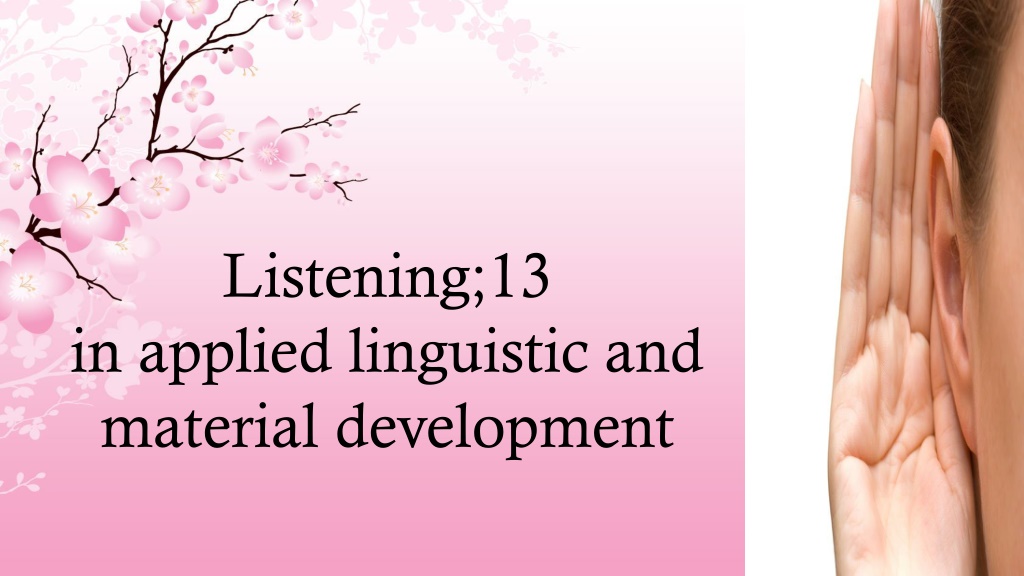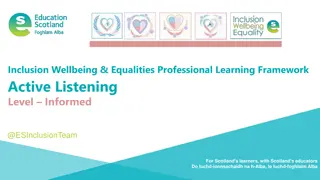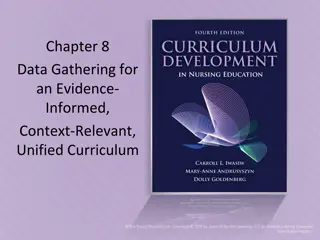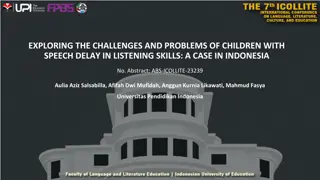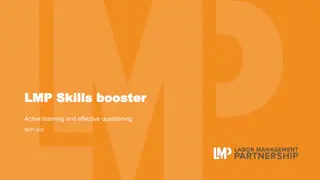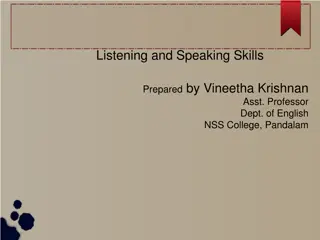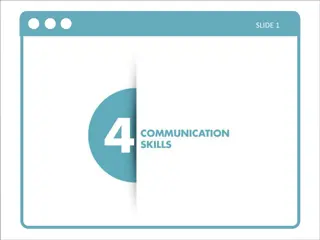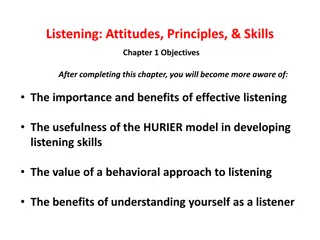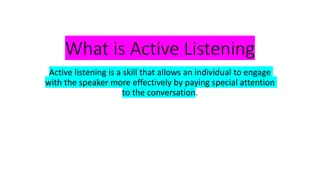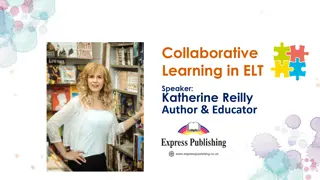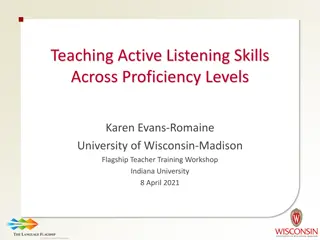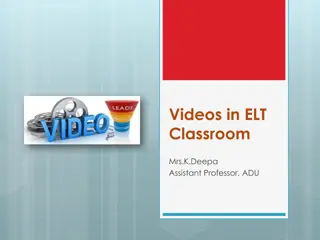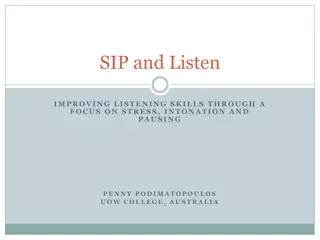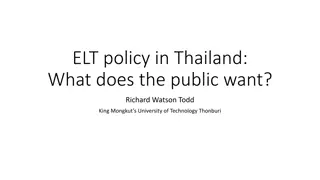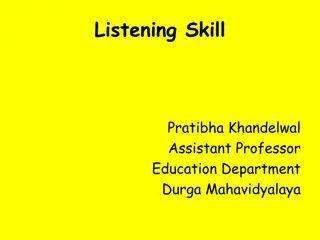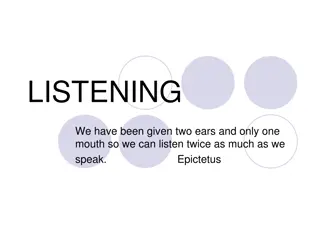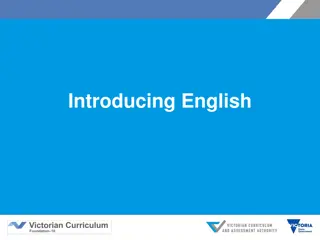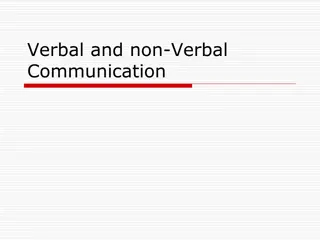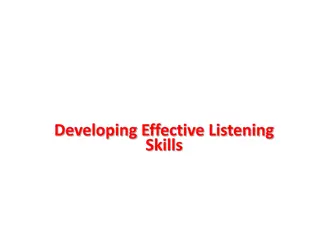Understanding the Role of Listening in ELT Curriculum
The role of listening in ELT curriculum is crucial as it involves receptive skills and cognitive processes like decoding. Research shows listening comprises 45% of communication engagement, highlighting its importance. Listening is not just hearing; it challenges learners with various language modes and varieties. Active listening contexts include one-way and two-way strategies. Strategies like metacognitive approach help improve listening comprehension and communication skills.
Download Presentation

Please find below an Image/Link to download the presentation.
The content on the website is provided AS IS for your information and personal use only. It may not be sold, licensed, or shared on other websites without obtaining consent from the author. Download presentation by click this link. If you encounter any issues during the download, it is possible that the publisher has removed the file from their server.
E N D
Presentation Transcript
Listening;13 in applied linguistic and material development
The role of listening in ELT curriculum Listening is receptive skills and involve decoding cognitive process exposure Research on ELT show that individual engage in communication:9 percent is devoted to writing ,16 percent to reading, 30 per sent to speaking ,and 45 percent to listening focus on Diagnostic test quanlitative approach
Listening is not just hearing For learners, listening presents a challenge for a variety of reasons , 1. listening involves multiple modes 2. listening involves all varieties of language
Active listening Contexts 1- one way (non participatory) listening 2- two way ( Participatory or interactive ) Listening
1- One Way Listening Have few or no opportunity to interact directly with the speaker Rely almost exclusively on their linguistic knowledge experience and factual knowledge to make sense of what they hear
Examples : Viewing or listing to recorded materials in a textbooks radio programs , songs , films , TV Programs , large lectures , presentations
2- Two way listening Participants in an interaction (casual Conversations , telephone conversations , Video conferencing, format interview , semi format interview , discussions , spontaneous presentations) .
Listening strategies : Ways of listening planning to improve communication and comprehension to cope with listening difficulties Metacognitive Strategy : Strategies that direct attention to the input and coordinate various cognitive Processes.
Metacognitive Strategy : -paying attention , monitoring and evaluation - Before , during and after listening - During face to face interaction , it can have a Social dimension - it can be developed in to " Automatized " listening skills
What do we know about listening process?
Bottom up processing : Is often used to describe the way meaning is built up from the sounds that have been decoded Top down processing : Is used to describe the way the meaning is infer and constructed from the application of prior and knowledge about language and the world stored in long term memory .
Types of knowledge that support listening comprehension Schema : background knowledge about the world derived from personal experiences an knowledge . The most common kind of knowledge which allows listeners to process in formation in a top down manner ( where gaps in comprehension are filled by what they know about )
2 types 1- knowledge of language Phonological knowledge : same stress pattern of " hotel " / " hostel " Grammatical knowledge : lemonade ? instead of " world you like a lemonade ? " Vocabulary knowledge : " chunks " = e.x the long and short of it / over the hill 2- knowledge of discourse and language use
Knowledge of discourse and language use: Each type of discourse is patterned differently and knowledge about how specific discourses are structured can enhance listening comprehension
Listening is reciprocal or participatory Brown and Yule used interaction to describe the social purpose of communication and transactional to describe the purpose of exchanging information.
What are the implications for the English language classroom? 1.Creating reasons for listening. 2.Selecting texts for listening 3.Designing listening activities for the classroom. 4.Buliding confidence in listening to English
Creating reasons for listening: General reasons participatory listening by Galvin; 1.To engage in social , rituals. 2.to exchange information 3.to exert control. 4.to share feeling 5.to enjoy yourself
Non-participatory listening categories by Underwood; purpose 1.listening to live conversation Curious eavesdropping. purpose 2.listening to announcements Extract information purpose 3.listening or watching enjoyment
4.following instruction carry out a task efficiency . to 5.attending a lecture or following a lesson Understand concepts and information. to 6.listening to someone give public address infer views and attitude. to
Galvin reasons and Underwood authentic listening situation: Harmer s purpose for classroom listening; 1.listening to confirm expectation 2.listening to extract specific information 3.listening for communicative tasks 4.listening to recognize function 5.listening to deduce meaning
Selecting texts for listening unscripted scripted Public announcement 1.monologue Type of text feature Unscripted, spontaneous conversation spontaneous commentary Telephone conversation 2.dialogue
Semi- authentic text authentic text Familiarize students with build confidence Some aspects of spoken discourse Provide variety of different accent, formality of language
So for improve the listening ; audio cassette and video cassette have its advantages; The teacher can work on the visual clues to meaning and provide the context of the listening. role relationships between speakers Cultural differences in interaction can be commented to build understanding of sociocultural background.
Designing listening activities for the classroom; Standards practices to use following procedure in dealing with a listening text; 1. teacher and students prepare for listening by helping students to familiar with the topic, expose to some lg features of the text. The teacher s role is to create interest, reasons for listening , and confidence to listen. 2.the teacher make sure that students understand what is involve in listening task. 3.students do the task independently. 4.In the feedback section , teacher and students check and discuss the response to the task. 5.Teacher focus on features of the text.
What materials currently do for teenagers? 1.Learners listen to a text at the same time as they read it. (This might learners to attend to aspects of phonology compared to orthography, although there is no task to point to this) 2.Learners listen to the past tense forms of verbs and write them in columns. They then listen again and check ( this might help learners recognize these particular past tense forms in continues speech ,but this does not appear to be the aim ,which is ,rather ,pronunciation) 3.Learners listen to a dialogue at the same time as they read it. 4.Lerner s listen to individual words and count syllables and mark stress( pronunciation ,practice ,no overtly linked to listening)
5.Learners listen to a brief narrative and match time periods to activities (the main purposes appears to be to provide information for learners subsequently, in pairs to practice asking and answering questions in the simple tense). 6.Learners listen to a dialogue at the same time as they read. 7.Learner listen to an anecdote describing an accident and read statements to decide if they are true or false according to the anecdote( this is strongly relates to the grammatical aim of the unit that is contrasting the past simple with the past progressive). 8.Learner listens to and repeats a d tongue twister. 9.Learners listen to reading text being read aloud, to check whether they performed a previous task (inserting time reference words) correctly. Listening with a focused on identification of particular lexical items)
10.Learners listen to the recounting of the life of famous person and complete a table of information, exclusively with dates and numbers (listening for specific predetermined information). 11.Learners listen to a dialogue at the same time as they read it.
Another approach for listening comprehension for adult course; learners first read advertisements with photos for accommodation to rent and then listen to a couple discussing them .the task for learners are as follows; Listen to Donna and Jose outside the estate agent s. Who likes the idea of moving? Who does not like the idea? Which places do they talk about? 2. Listen again 1. Why does Jose think they cannot move? (Two reasons) 2. What solution does Donna suggest?
pre-listening task for preparing the students: 1.personolize the topic , elicit vocabulary in the texts. 2.move into discussion of the text and encourage prediction of some of the points. 3.prepare students for overall organization of the text and this activity will facilitate note-making.
Objective of pre-listening phaseis :to contextualize the text. Students need to form an opinion and the useful task is to invite students to make explicit their opinion to each other.
Post-listening activity; This phase involve integration with other skills, through development of he topic into the reading , speaking , writing , activities. e.g: Invite students to the talk about other animal and bring the topic full circle.
Product or process? In product only the outcome is important In process; what they want to communicate is the central role in process approach
an example of task from levels of Redston and Cunningham the tasks are paraphrased here. Elementary level a)look at the photos b)put the photos in order c)listen again and answer question. Upper intermediate level a)look at the picture b)listen and put the picture in order c)listen again and answer question.
Listening task; learners listen to a dialogue in a restaurant and complete phrase ( I ll .).the objective here seem to be to focus on useful lexical phrase(I ll get this =I ll pay for this).learners have to pick out the phrases within the flow of speech thus working
Another example; after listening to a text, listen to a part of it again and complete missing chunks of language which feature elements of assimilation or elision. Since if the text are well-recorded in the sense that they retain features of natural speech such as assimilation elision weak sound then learner are getting practice in perception in hearing words that they can see and that they more or less know in various phonological context.
Conclusion; The most vital element in learning is to listen effectively in a second or foreign language is confidence. All the listening activities have placed the learner in the role of eavesdropper listening to more or less formal dialogue or listening to a monologue.
